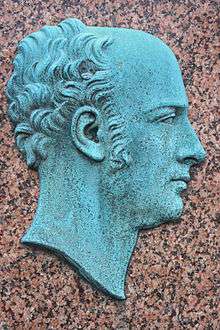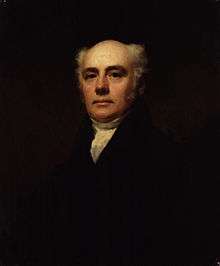Hugh William Williams

Hugh William Williams FRSE (1773–1829), known as "Grecian Williams", was a Scottish landscape-painter.


Life
Williams was born on board the ship of his father, Captain Williams, whilst en route to the West Indies. His mother, "Miss Lewis", died in 1782, and his father, being unable to care for the nine-year-old Hugh, left him in the care of Louis Ruffini, a textile manufacturer in Dalkeith.[1] Ruffini encouraged Hugh to become a painter.[2] For some years he concentrated on Highland landscapes.[3]
An extended tour in Italy and Greece, from which he returned in 1818, gave his work its particular character, and earned him the nickname "Grecian Williams". In 1822 Williams held an exhibition of watercolours, based on his tour. It was a critical success, its ruins and famous scenes of Greek history chiming with the taste of the time.[3]
Williams was an original member of the Associated Artists in Watercolour (1808), with Andrew Wilson, which was short-lived;[2] and an associate of the Royal Institution, Edinburgh. Towards the end of his life he took an interest in the proposed amalgamation of the Scottish Academy and the artist associates of the Institution, an arrangement which was completed a month after his death.
He was elected a Fellow of the Royal Society of Edinburgh in 1823 his proposer being Sir David Brewster.
He died on 23 June 1829.[3] He is buried in Canongate Kirkyard in the lair of his in-laws, the Millars of Earnock. His wife Robina Millar died in 1874.[4] The grave lies in the eastern extension, adjacent to the link to the main churchyard.
Works

In 1811–12 Williams published six large engravings of scenes in the north, while many of his early topographical drawings appeared in the Scots Magazine. An account of his travels in southern Europe, in two volumes, appeared in 1820. Written in the form of letters, and dedicated to John Thomson of Duddingston, the intention of the work was descriptive of scenery, and peoples as they appeared to him. The illustrations were engraved by William Home Lizars from drawings by the author.[3]
Between 1827 and 1829 Williams published Select Views in Greece in numbers, each containing six plates. While he painted some oil pictures, he mostly used watercolour, in broad washes of transparent colour over a careful pencil design. His work was acquired by the National Gallery of Scotland and South Kensington Museum.[3]
Family
Shortly after his return from the Near East Williams married Miss Miller of Garnock, a wealthy lady. They moved in Edinburgh society, where he was popular.[3]
Notes
- ↑ BIOGRAPHICAL INDEX OF FORMER FELLOWS OF THE ROYAL SOCIETY OF EDINBURGH 1783 – 2002 (PDF). The Royal Society of Edinburgh. July 2006. ISBN 0 902 198 84 X.
- 1 2 Campbell, Mungo. "Williams, Hugh William". Oxford Dictionary of National Biography (online ed.). Oxford University Press. doi:10.1093/ref:odnb/29511. (Subscription or UK public library membership required.)
- 1 2 3 4 5 6
 Lee, Sidney, ed. (1900). "Williams, Hugh William". Dictionary of National Biography. 61. London: Smith, Elder & Co.
Lee, Sidney, ed. (1900). "Williams, Hugh William". Dictionary of National Biography. 61. London: Smith, Elder & Co. - ↑ BIOGRAPHICAL INDEX OF FORMER FELLOWS OF THE ROYAL SOCIETY OF EDINBURGH 1783 – 2002 (PDF). The Royal Society of Edinburgh. July 2006. ISBN 0 902 198 84 X.
| Wikimedia Commons has media related to Hugh William Williams. |
External links
- 7 Painting(s) by or after Hugh William Williams at the Art UK site
Attribution
![]() This article incorporates text from a publication now in the public domain: Lee, Sidney, ed. (1900). "Williams, Hugh William". Dictionary of National Biography. 61. London: Smith, Elder & Co.
This article incorporates text from a publication now in the public domain: Lee, Sidney, ed. (1900). "Williams, Hugh William". Dictionary of National Biography. 61. London: Smith, Elder & Co.